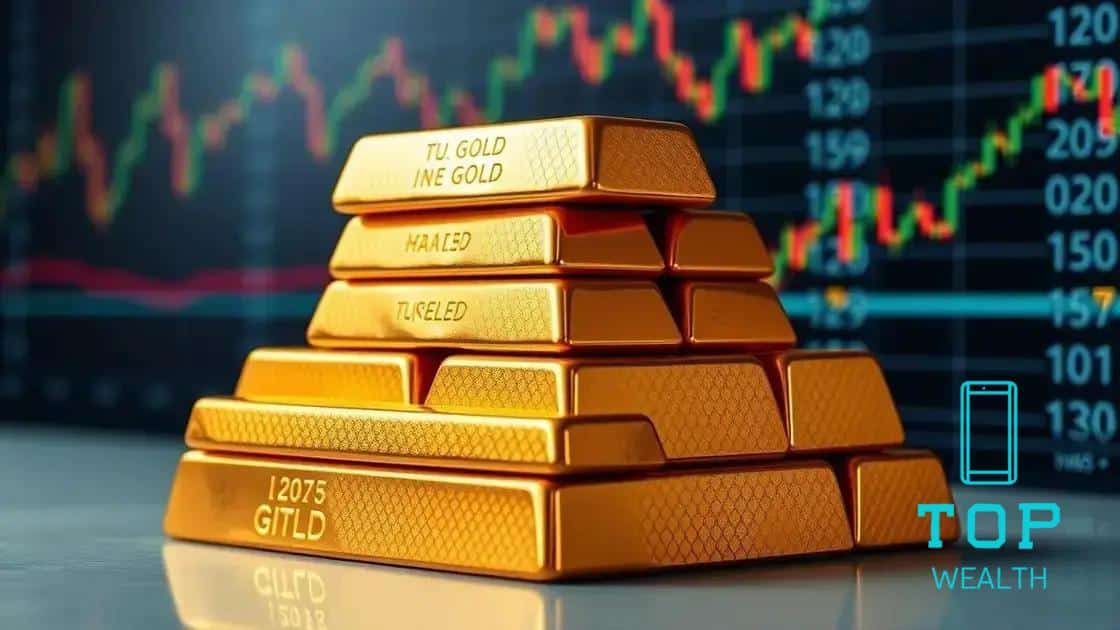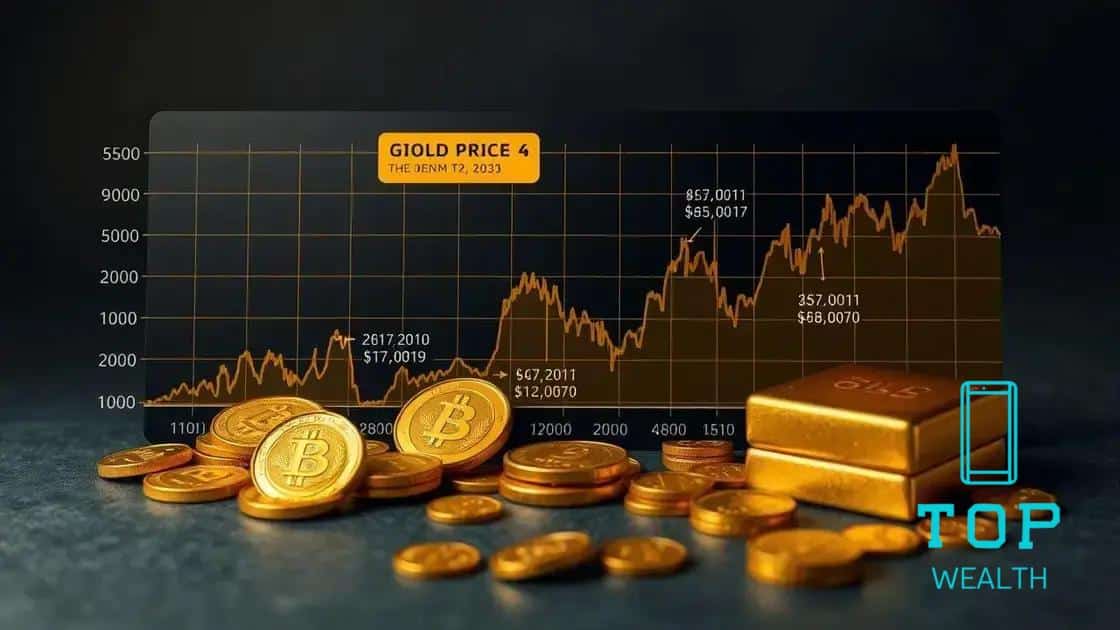Gold demand surges during financial uncertainty

Gold demand surges during financial uncertainty as investors seek stability and protection from market volatility, making it a crucial asset for safeguarding wealth and navigating economic crises.
Gold demand surges during financial uncertainty, capturing the attention of investors seeking stability. But why does this precious metal gain such allure when markets falter? Let’s delve into this phenomenon and explore its implications for your investments.
Understanding the rise in gold demand
The increasing demand for gold during uncertain times is a phenomenon that many investors have observed. As financial markets fluctuate, people are turning to gold for stability and security. Understanding this surge in demand can help you make informed decisions about your investments.
Reasons for Increased Demand
When uncertainty looms, the perceived value of gold rises. Investors often see gold as a safe haven. It protects wealth from market volatility, inflation, and economic downturns.
- Gold has intrinsic value, unlike paper currency
- It acts as a hedge against inflation
- Gold retains its value over time
- Global crises increase gold purchases
During difficult financial times, central banks often increase their gold reserves. This move signals confidence in gold as a secure asset. Additionally, high demand from countries like India and China contributes to rising prices.
Current Trends in Gold Investing
With the advent of digital gold and exchange-traded funds (ETFs), investing in gold has become more accessible. These options allow even small investors to include gold in their portfolios. Many financial advisors recommend having a specific percentage of gold for a balanced investment strategy.
- Digital gold provides flexibility for small investors
- ETFs offer liquidity and ease of trading
- Diversifying portfolios with gold can reduce risks
The emergence of avenues like online platforms for gold purchasing has simplified the investing process. Investors can now buy gold without needing to visit physical stores, making it easier to respond quickly to market changes.
The future of gold demand will likely continue to fluctuate along with global market conditions. As uncertainties rise, understanding the dynamics of gold demand is crucial for strategic investment decisions. Keeping an eye on economic indicators can help predict shifts in gold prices.
Factors driving gold purchases

Several key factors are driving gold purchases higher in today’s market. As global uncertainty rises, more investors are turning to gold as a solid investment option. This precious metal is not just a safe haven but also a traditional store of value.
Economic Instability
When the economy is unstable, many people seek to protect their wealth. Gold often sees a surge in demand during such times. Investors perceive it as a refuge against inflation and market downturns. This belief leads to increased purchases, which can elevate gold’s price significantly.
- Financial crises boost gold’s allure
- Gold traditionally holds its value
- Investors fear currency devaluation
- Increasing global debt levels
In addition to economic instability, political turmoil also plays a significant role. Tensions in geopolitics make investors anxious, prompting them to gravitate towards gold as a reliable asset. For example, conflicts and sanctions can lead to increased gold demand as countries look to secure their finances.
Changing Investment Trends
As financial markets evolve, so do investor preferences. The rise of online trading has made it easier for people to buy gold. Many individuals prefer gold-backed exchange-traded funds (ETFs), which offer a convenient way to invest without the need for physical storage. This shift has opened up gold investments to a broader audience.
- Accessibility through online trading platforms
- Gold ETFs provide liquid investment options
- Young investors are more inclined to include gold
- Diversifying portfolios with gold appeals to new investors
Market trends show a growing awareness of gold’s potential benefits. Additionally, the rise of digital currencies has prompted some to view gold as a safer, more tangible investment. This juxtaposition contributes to increased purchases, as many see gold as a reliable hedge against the digital market’s volatility.
How investors can leverage gold during crises
During financial crises, investors often look for ways to leverage gold to protect and grow their wealth. This precious metal not only serves as a safe haven but also offers unique opportunities for strategic investment. Understanding how to effectively utilize gold can make a significant difference in turbulent times.
Buying Physical Gold
One of the most traditional methods of investing in gold is by purchasing physical gold. Investors can acquire gold coins, bars, or jewelry. This tangible asset provides a sense of security during crises. However, it’s essential to consider storage and insurance options.
- Invest in reputable dealers to ensure quality
- Secure proper storage to protect your investment
- Consider insurance for larger purchases
- Stay informed about market trends and pricing
Holding physical gold offers the advantage of being unaffected by electronic risks. When markets dive, the demand for gold tends to increase, potentially boosting its value. Investors can sell their physical gold at a higher price when demand peaks.
Gold ETFs and Mutual Funds
Gold exchange-traded funds (ETFs) and mutual funds provide a modern and convenient way to invest in gold. These financial instruments allow investors to buy shares representing a portion of gold holdings without the need to physically store the metal. As crises unfold, gold ETFs often outperform traditional stocks, making them an attractive option.
- Gold ETFs offer easy buying and selling
- Low management fees compared to traditional funds
- Allows for diversification within an investment portfolio
- Access to real-time pricing and liquidity
Investors benefit from gold ETFs by gaining exposure to the price movements of gold while enjoying liquidity and flexibility. This approach minimizes risks associated with physical ownership and simplifies the investment process.
Using Options and Futures
For more advanced investors, trading gold options and futures can be a strategic way to profit during financial downturns. These derivative instruments allow investors to bet on future price movements. By understanding market signals, experienced investors can capitalize on price fluctuations.
- Options provide leverage with lower capital requirements
- Futures contracts allow for hedging against declines in value
- Both can diversify investment strategies significantly
- Requires knowledge of market conditions and trends
While these strategies offer potential rewards, they also come with risks. Investors should conduct thorough research and perhaps consult financial advisors before venturing into these markets.
Historical trends in gold prices during uncertainty

Historically, gold prices have shown a strong correlation with economic uncertainty. Whenever crises arise, be it financial or political, investors flock to gold. This behavior shifts the demand and consequently impacts gold prices significantly. Understanding these trends provides insights into how gold can serve as a reliable investment during tough times.
Price Surges in Past Crises
During major economic downturns, the price of gold often experiences substantial rises. For instance, during the 2008 financial crisis, gold prices increased as investors sought safety. The fear of recession caused many to shift their assets into gold, driving the price per ounce higher.
- In 2008, gold rose from around $800 to over $1,900 per ounce.
- The COVID-19 pandemic saw similar trends, with prices hitting record highs.
- Political tensions often result in immediate spikes in gold prices.
- Investors view gold as a hedge against currency devaluation during instability.
These historical patterns highlight gold’s role as a protective asset. Investors often turn to gold when they fear losing value in other asset classes. For example, during significant geopolitical events, prices may rise swiftly as panic sets in.
Long-Term Trends
Looking at long-term data reveals that gold prices tend to appreciate during prolonged periods of uncertainty. The trends indicate that even when prices fluctuate in the short term, gold remains a solid investment. It can provide a cushion against market volatility and inflation over the years.
- Long-term upward trend amid economic stress.
- Gold historically provides better returns than traditional savings.
- It often outpaces inflation rates over decades.
- Investors frequently retain gold in diversified portfolios.
As financial systems evolve, so does gold’s position in market dynamics. The increasing demand for gold during turmoil tends to stabilize its price over the long run. Understanding these historical trends is vital for any investor looking to navigate uncertain times effectively.
Future outlook for gold investment
The future outlook for gold investment remains bright despite the ups and downs of financial markets. As economic uncertainties continue to influence investor behavior, gold is expected to maintain its appeal as a safe haven asset. With ongoing inflation concerns and geopolitical tensions, many look to gold as a reliable investment opportunity.
Demand Projections
Analysts predict that the demand for gold will continue to grow in the coming years. Factors contributing to this trend include increasing investment in emerging markets and ongoing central bank purchases. These central banks often add gold to their reserves as a precaution, further driving demand.
- Emerging economies are increasing their gold purchases.
- Central banks tend to diversify their holdings with gold.
- Gold jewelry demand in countries like India is steadily rising.
- Cross-border trade tensions could increase gold’s desirability.
The expected economic conditions indicate that gold investment can benefit from sustained demand in various sectors, enhancing its role in global finance. Additionally, the rise of digital gold continues to make investment more accessible to the average person.
Technological Innovations
With advancements in technology, buying and selling gold has never been easier. Digital platforms and mobile applications allow investors to trade gold effortlessly. These innovations simplify the process of investing, thus attracting younger generations who prefer convenience and efficiency in their financial activities.
- Digital gold allows for micro-investing and flexibility.
- Investment apps make tracking gold prices straightforward.
- Blockchain technology enhances gold tracking and ownership verification.
- Online trading reduces transaction costs for investors.
As innovations continue to unfold, they may lead to new investment products that enhance gold’s attractiveness. These developments could cater to a wider audience, especially millennials and Gen Z investors.
Economic Factors to Watch
Various economic factors will play a crucial role in determining gold’s future. Inflation remains a significant concern as rising prices erode purchasing power. In addition, political stability and interest rates will heavily influence gold’s price movements. Investors should pay close attention to these factors to make informed decisions about their gold investments.
- Monitor inflation rates and their impact on gold prices.
- Geopolitical issues may spur demand for gold.
- Interest rate changes can affect investment strategies.
- Stay informed about fiscal policies and their implications for gold.
The overall outlook for gold investment is optimistic. With continuous demand, technological advancements, and relevant economic factors at play, gold is likely to remain a key asset in the investment landscape.
FAQ – Common Questions About Gold Investment
Why is gold considered a safe haven during financial crises?
Gold is regarded as a safe haven because it tends to retain its value when markets decline, providing stability and security for investors.
How can investors buy gold?
Investors can purchase gold in various forms such as physical bars, coins, ETFs, or mutual funds, each offering different advantages.
What economic factors influence gold prices?
Gold prices are influenced by factors such as inflation rates, political stability, and central bank policies, all of which can affect investor demand.
What are the benefits of investing in gold technology?
Technological advances have made it easier to invest in gold through digital platforms, offering accessibility and convenience for both new and experienced investors.





